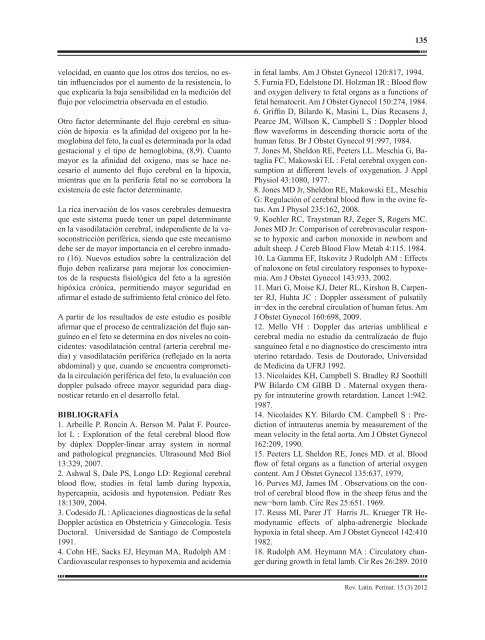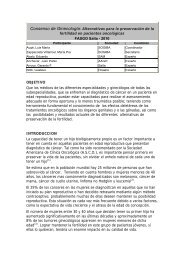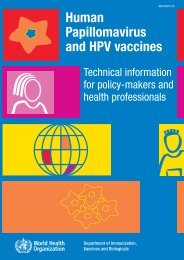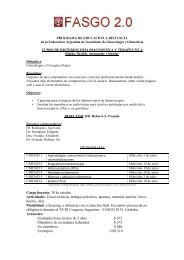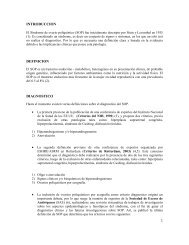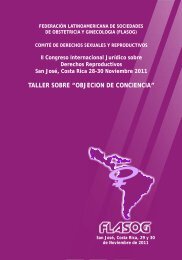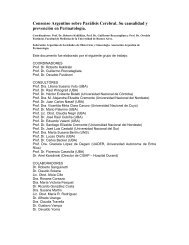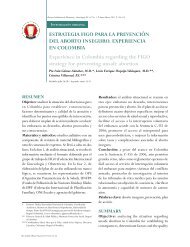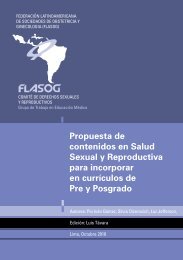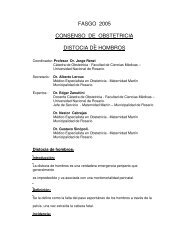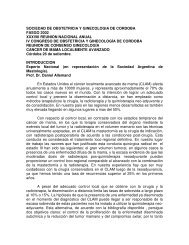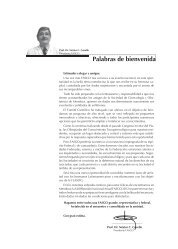Volumen 15 (3) de septiembre 2012 - fasgo
Volumen 15 (3) de septiembre 2012 - fasgo
Volumen 15 (3) de septiembre 2012 - fasgo
You also want an ePaper? Increase the reach of your titles
YUMPU automatically turns print PDFs into web optimized ePapers that Google loves.
velocidad, en cuanto que los otros dos tercios, no están<br />
influenciados por el aumento <strong>de</strong> la resistencia, lo<br />
que explicaría la baja sensibilidad en la medición <strong>de</strong>l<br />
flujo por velocimetria observada en el estudio.<br />
Otro factor <strong>de</strong>terminante <strong>de</strong>l flujo cerebral en situación<br />
<strong>de</strong> hipoxia es la afinidad <strong>de</strong>l oxigeno por la hemoglobina<br />
<strong>de</strong>l feto, la cual es <strong>de</strong>terminada por la edad<br />
gestacional y el tipo <strong>de</strong> hemoglobina, (8,9). Cuanto<br />
mayor es la afinidad <strong>de</strong>l oxigeno, mas se hace necesario<br />
el aumento <strong>de</strong>l flujo cerebral en la hipoxia,<br />
mientras que en la periferia fetal no se corrobora la<br />
existencia <strong>de</strong> este factor <strong>de</strong>terminante.<br />
La rica inervación <strong>de</strong> los vasos cerebrales <strong>de</strong>muestra<br />
que este sistema pue<strong>de</strong> tener un papel <strong>de</strong>terminante<br />
en la vasodilatación cerebral, in<strong>de</strong>pendiente <strong>de</strong> la vasoconstricción<br />
periférica, siendo que este mecanismo<br />
<strong>de</strong>be ser <strong>de</strong> mayor importancia en el cerebro inmaduro<br />
(16). Nuevos estudios sobre la centralización <strong>de</strong>l<br />
flujo <strong>de</strong>ben realizarse para mejorar los conocimientos<br />
<strong>de</strong> la respuesta fisiológica <strong>de</strong>l feto a la agresión<br />
hipóxica crónica, permitiendo mayor seguridad en<br />
afirmar el estado <strong>de</strong> sufrimiento fetal crónico <strong>de</strong>l feto.<br />
A partir <strong>de</strong> los resultados <strong>de</strong> este estudio es posible<br />
afirmar que el proceso <strong>de</strong> centralización <strong>de</strong>l flujo sanguíneo<br />
en el feto se <strong>de</strong>termina en dos niveles no coinci<strong>de</strong>ntes:<br />
vasodilatación central (arteria cerebral media)<br />
y vasodilatación periférica (reflejado en la aorta<br />
abdominal) y que, cuando se encuentra comprometida<br />
la circulación periférica <strong>de</strong>l feto, la evaluación con<br />
doppler pulsado ofrece mayor seguridad para diagnosticar<br />
retardo en el <strong>de</strong>sarrollo fetal.<br />
BIBLIOGRAFÍA<br />
1. Arbeille P. Roncin A. Berson M. Palat F. Pourcelot<br />
L : Exploration of the fetal cerebral blood flow<br />
by dúplex Doppler-linear array system in normal<br />
and pathological pregnancies. Ultrasound Med Biol<br />
13:329, 2007.<br />
2. Ashwal S, Dale PS, Longo LD: Regional cerebral<br />
blood flow, studies in fetal lamb during hypoxia,<br />
hypercapnia, acidosis and hypotension. Pediatr Res<br />
18:1309, 2004.<br />
3. Co<strong>de</strong>sido JL : Aplicaciones diagnosticas <strong>de</strong> la señal<br />
Doppler acústica en Obstetricia y Ginecología. Tesis<br />
Doctoral. Universidad <strong>de</strong> Santiago <strong>de</strong> Compostela<br />
1991.<br />
4. Cohn HE, Sacks EJ, Heyman MA, Rudolph AM :<br />
Cardiovascular responses to hypoxemia and aci<strong>de</strong>mia<br />
135<br />
in fetal lambs. Am J Obstet Gynecol 120:817, 1994.<br />
5. Furnia FD, E<strong>de</strong>lstone DI. Holzman IR : Blood flow<br />
and oxygen <strong>de</strong>livery to fetal organs as a functions of<br />
fetal hematocrit. Am J Obstet Gynecol <strong>15</strong>0:274, 1984.<br />
6. Griffin D, Bilardo K, Masini L, Dias Recasens J,<br />
Pearce JM, Willson K, Campbell S : Doppler blood<br />
flow waveforms in <strong>de</strong>scending thoracic aorta of the<br />
human fetus. Br J Obstet Gynecol 91:997, 1984.<br />
7. Jones M, Sheldon RE, Peeters LL. Meschia G, Bataglia<br />
FC, Makowski EL : Fetal cerebral oxygen consumption<br />
at different levels of oxygenation. J Appl<br />
Physiol 43:1080, 1977.<br />
8. Jones MD Jr, Sheldon RE, Makowski EL, Meschia<br />
G: Regulación of cerebral blood flow in the ovine fetus.<br />
Am J Physol 235:162, 2008.<br />
9. Koehler RC, Traystman RJ, Zeger S, Rogers MC.<br />
Jones MD Jr: Comparison of cerebrovascular response<br />
to hypoxic and carbon monoxi<strong>de</strong> in newborn and<br />
adult sheep. J Cereb Blood Flow Metab 4:1<strong>15</strong>. 1984.<br />
10. La Gamma EF, Itskovitz J Rudolph AM : Effects<br />
of naloxone on fetal circulatory responses to hypoxemia.<br />
Am J Obstet Gynecol 143:933, 2002.<br />
11. Mari G, Moise KJ, Deter RL, Kirshon B, Carpenter<br />
RJ, Huhta JC : Doppler assessment of pulsatily<br />
in¬<strong>de</strong>x in the cerebral circulation of human fetus. Am<br />
J Obstet Gynecol 160:698, 2009.<br />
12. Mello VH : Doppler das arterias umblilical e<br />
cerebral media no estudio da centralizacáo <strong>de</strong> flujo<br />
sanguíneo fetal e no diagnostico do crescimento intra<br />
uterino retardado. Tesis <strong>de</strong> Doutorado, Universidad<br />
<strong>de</strong> Medicina da UFRJ 1992.<br />
13. Nicolai<strong>de</strong>s KH, Campbell S. Bradley RJ Soothill<br />
PW Bilardo CM GIBB D . Maternal oxygen therapy<br />
for intrauterine growth retardation. Lancet 1:942.<br />
1987.<br />
14. Nicolai<strong>de</strong>s KY. Bilardo CM. Campbell S : Prediction<br />
of intrauterus anemia by measurement of the<br />
mean velocity in the fetal aorta. Am J Obstet Gynecol<br />
162:209, 1990.<br />
<strong>15</strong>. Peeters LL Sheldon RE, Jones MD. et al. Blood<br />
flow of fetal organs as a function of arterial oxygen<br />
content. Am J Obstet Gynecol 135:637, 1979,<br />
16. Purves MJ, James IM . Observations on the control<br />
of cerebral blood flow in the sheep fetus and the<br />
new¬born lamb. Circ Res 25:651. 1969.<br />
17. Reuss MI, Parer JT Harris JL. Krueger TR Hemodynamic<br />
effects of alpha-adrenergic blocka<strong>de</strong><br />
hypoxia in fetal sheep. Am J Obstet Gynecol 142:410<br />
1982.<br />
18. Rudolph AM. Heymann MA : Circulatory changer<br />
during growth in fetal lamb. Cir Res 26:289. 2010<br />
Rev. Latin. Perinat. <strong>15</strong> (3) <strong>2012</strong>


